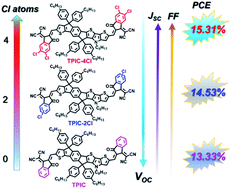Efficient modulation of end groups for the asymmetric small molecule acceptors enabling organic solar cells with over 15% efficiency†
Abstract
Non-fullerene organic solar cells (OSCs) have attracted tremendous interest and made an impressive breakthrough, largely due to advances in high-performance small molecule acceptors (SMAs). The relationship between short-circuit current density (JSC) and open-circuit voltage (VOC) is usually shown as one falls, the other rises. Controlling the trade-off between JSC and VOC to harvest high power conversion efficiencies (PCEs) still remains as a challenge. Herein, dithieno[3,2-b:2′,3′-d]pyrrole (DTP) based asymmetric SMAs with different chlorinated dicyanoindanone-based end groups, named TPIC, TPIC-2Cl and TPIC-4Cl, are designed and synthesized. These asymmetric acceptors exhibit a remarkable red-shifted absorption profile, while energy levels are simultaneously down-shifted when the numbers of chlorine atoms alter from 0, 1 to 2, due to the gradually improved electronegativity. As a result, PM7:TPIC-4Cl based OSCs achieved a champion PCE of 15.31%, which is the highest PCE for non-fullerene binary OSCs based on asymmetric SMAs. The superiority of the PM7:TPIC-4Cl system consists of the balanced charge transport, favorable phase separation, efficient exciton dissociation and extraction, coupled with the remarkable π–π stacking and crystallinity of the SMAs. Our results highlight the important strategy of asymmetric molecular design to optimize the trade-off between VOC and JSC, reaching a high PCE.



 Please wait while we load your content...
Please wait while we load your content...